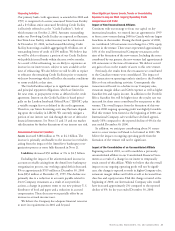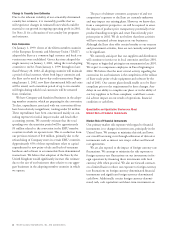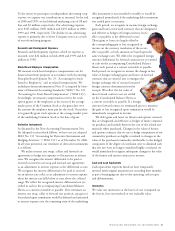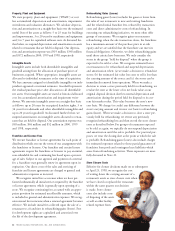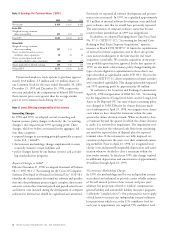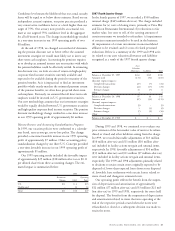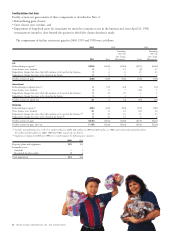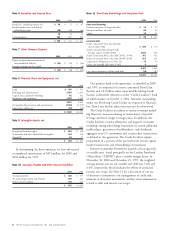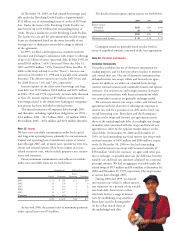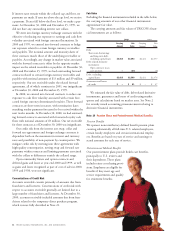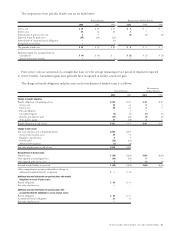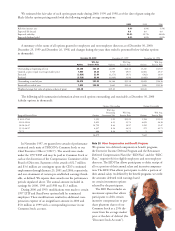Pizza Hut 2000 Annual Report Download - page 49
Download and view the complete annual report
Please find page 49 of the 2000 Pizza Hut annual report below. You can navigate through the pages in the report by either clicking on the pages listed below, or by using the keyword search tool below to find specific information within the annual report.
TRICON GLOBAL RESTAURANTS, INC. AND SUBSIDIARIES 47
previously closed stores. These costs are expensed as incurred.
Additionally, we record a liability for the net present value of
any remaining operating lease obligations after the expected
closure date, net of estimated sublease income, if any, at the
date the closure is considered probable.
Considerable management judgment is necessary to esti-
mate future cash flows. Accordingly, actual results could vary
significantly from the estimates.
Impairment of Long-Lived Assets
We review our long-lived assets related to each restaurant
to be held and used in the business, including any allocated
intangible assets, semi-annually for impairment, or whenever
events or changes in circumstances indicate that the carrying
amount of a restaurant may not be recoverable. We evaluate
restaurants using a “two-year history of operating losses” as
our primary indicator of potential impairment. Based on the
best information available, we write down an impaired restau-
rant to its estimated fair market value, which becomes its new
cost basis. We generally measure estimated fair market value
by discounting estimated future cash flows. In addition, after
April 23, 1998, when we decide to close a store beyond the
quarter in which the closure decision is made, it is reviewed
for impairment and depreciable lives are adjusted. The impair-
ment evaluation is based on the estimated cash flows from
continuing use until the expected disposal date plus the
expected terminal value.
Considerable management judgment is necessary to esti-
mate future cash flows. Accordingly, actual results could vary
significantly from our estimates.
Impairment of Investments in Unconsolidated Affiliates
and Enterprise-Level Goodwill
Our methodology for determining and measuring impairment
of our investments in unconsolidated affiliates and enterprise-
level goodwill is similar to the methodology we use for our
restaurants except: (a) the recognition test for an investment
in an unconsolidated affiliate compares the carrying amount
of our investment to a forecast of our share of the unconsoli-
dated affiliate’s undiscounted cash flows after interest and
taxes instead of undiscounted cash flows before interest and
taxes used for our restaurants; and (b) enterprise-level good-
will is generally evaluated at a country level instead of by
individual restaurant. Also, we record impairment charges
related to investments in unconsolidated affiliates whenever
other circumstances indicate that a decrease in the value of
an investment has occurred which is other than temporary.
Considerable management judgment is necessary to esti-
mate future cash flows. Accordingly, actual results could vary
significantly from our estimates.
New Accounting Pronouncement Not Yet Adopted
In June 1998, the Financial Accounting Standards Board (the
“FASB”) issued SFAS 133. SFAS 133 establishes accounting
and reporting standards requiring that every derivative instru-
ment (including certain derivative instruments embedded in
other contracts) be recorded in the balance sheet as either an
asset or liability measured at its fair value. SFAS 133 requires
that changes in the derivative’s fair value be recognized currently
in earnings unless specific hedge accounting criteria are met.
Special accounting for qualifying hedges allows a derivative’s
gains and losses to offset the related change in fair value on
the hedged item in the Consolidated Statements of Income
or be deferred through Accumulated Other Comprehensive
Income until a hedged forecasted transaction affects earnings.
SFAS 133 requires that a company formally document, desig-
nate and assess the effectiveness of transactions to receive
hedge accounting treatment. In June 2000, the FASB issued
SFAS No. 138, “Accounting for Certain Derivative Instru-
ments and Certain Hedging Activities,” which amended
certain provisions of SFAS 133.
As required, we adopted these statements on December 31,
2000, which is the beginning of our 2001 fiscal year. The
transition adjustments resulting from the adoption of SFAS 133
were not significant. In addition, the adoption of these state-
ments could increase volatility in our earnings and other
comprehensive income.
Note 3 Comprehensive Income
Accumulated Other Comprehensive Income of $177 million
and $133 million as of December 30, 2000 and December 25,
1999, respectively, consisted entirely of foreign currency
translation adjustment.
The changes in foreign currency translation adjustment
are as follows:
2000 1999 1998
Foreign currency translation adjustment
arising during the period $(44) $15 $(21)
Less: Foreign currency translation
adjustment included in net income ––1
Net foreign currency translation
adjustment $(44) $15 $(20)


